The NVIDIA GeForce GTX 980 Ti Review
by Ryan Smith on May 31, 2015 6:00 PM ESTCompute
Shifting gears, we have our look at compute performance. Since GTX Titan X has no compute feature advantage - no fast double precision support like what's found in the Kepler generation Titans - the performance difference between the GTX Titan X and GTX 980 Ti should be very straightforward.
Starting us off for our look at compute is LuxMark3.0, the latest version of the official benchmark of LuxRender 2.0. LuxRender’s GPU-accelerated rendering mode is an OpenCL based ray tracer that forms a part of the larger LuxRender suite. Ray tracing has become a stronghold for GPUs in recent years as ray tracing maps well to GPU pipelines, allowing artists to render scenes much more quickly than with CPUs alone.
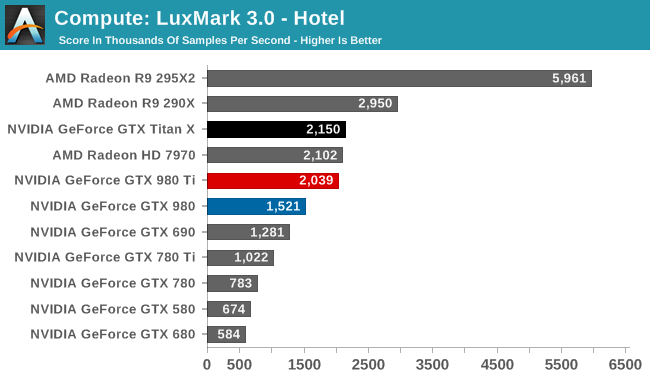
With the pace set for GM200 by GTX Titan X, there’s little to say here that hasn’t already been said. Maxwell does not fare well in LuxMark, and while GTX 980 Ti continues to stick very close to GTX Titan X, it none the less ends up right behind the Radeon HD 7970 in this benchmark.
For our second set of compute benchmarks we have CompuBench 1.5, the successor to CLBenchmark. CompuBench offers a wide array of different practical compute workloads, and we’ve decided to focus on face detection, optical flow modeling, and particle simulations.
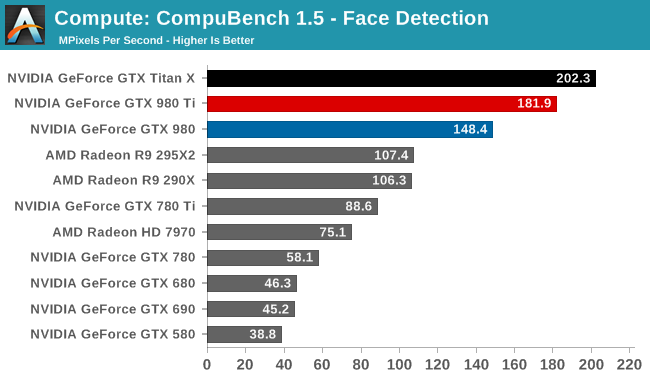
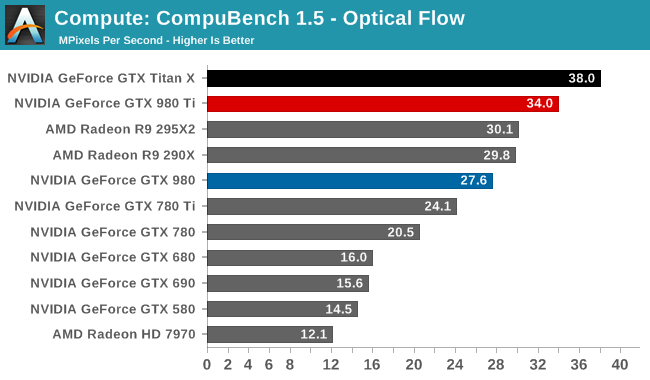
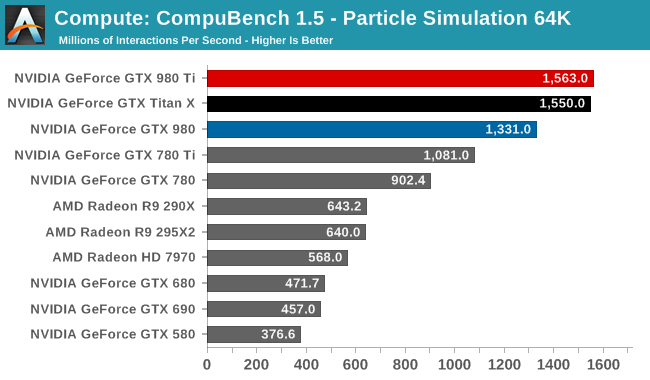
Although GTX T980 Ti struggled at LuxMark, the same cannot be said for CompuBench. Though taking the second spot in all 3 sub-tests - right behind GTX Titan X - there's a bit wider of a gap than normal between the two GM200 cards, causing GTX 980 Ti to trail a little more significantly than in other tests. Given the short nature of these tests, GTX 980 Ti doesn't get to enjoy its usual clockspeed advantage, making this one of the only benchmarks where the theoretical 9% performance difference between the cards becomes a reality.
Our 3rd compute benchmark is Sony Vegas Pro 13, an OpenGL and OpenCL video editing and authoring package. Vegas can use GPUs in a few different ways, the primary uses being to accelerate the video effects and compositing process itself, and in the video encoding step. With video encoding being increasingly offloaded to dedicated DSPs these days we’re focusing on the editing and compositing process, rendering to a low CPU overhead format (XDCAM EX). This specific test comes from Sony, and measures how long it takes to render a video.

Traditionally a benchmark that favors AMD, GTX 980 Ti fares as well as GTX Titan X, closing the gap some. But it's still not enough to surpass Radeon HD 7970, let alone Radeon R9 290X.
Moving on, our 4th compute benchmark is FAHBench, the official Folding @ Home benchmark. Folding @ Home is the popular Stanford-backed research and distributed computing initiative that has work distributed to millions of volunteer computers over the internet, each of which is responsible for a tiny slice of a protein folding simulation. FAHBench can test both single precision and double precision floating point performance, with single precision being the most useful metric for most consumer cards due to their low double precision performance. Each precision has two modes, explicit and implicit, the difference being whether water atoms are included in the simulation, which adds quite a bit of work and overhead. This is another OpenCL test, utilizing the OpenCL path for FAHCore 17.
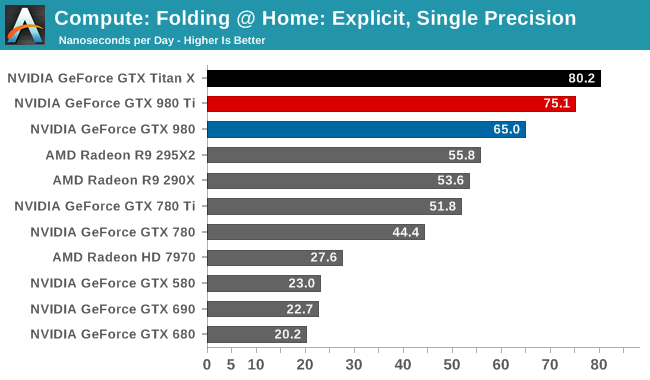
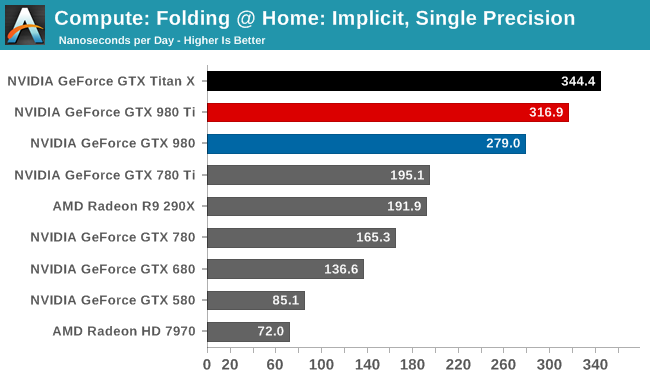
Folding @ Home’s single precision tests reiterate GM200's FP32 compute credentials. Second only to GTX Titan X, GTX 980 Ti fares very well here.
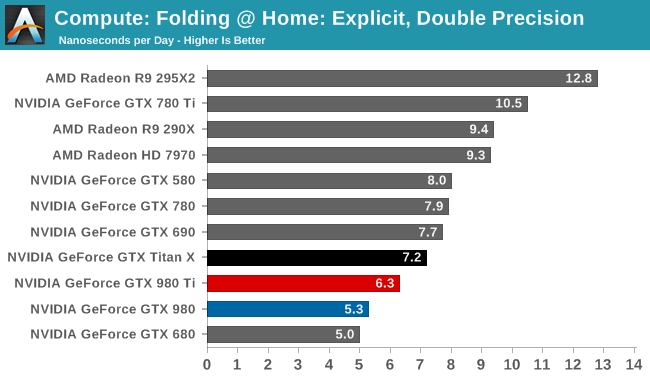
Meanwhile Folding @ Home’s double precision test reiterates GM200's poor FP64 compute performance. At 6.3ns/day, it, like the GTX Titan X, occupies the lower portion of our benchmark charts, below AMD's cards and NVIDIA's high-performnace FP64 cards.
Wrapping things up, our final compute benchmark is an in-house project developed by our very own Dr. Ian Cutress. SystemCompute is our first C++ AMP benchmark, utilizing Microsoft’s simple C++ extensions to allow the easy use of GPU computing in C++ programs. SystemCompute in turn is a collection of benchmarks for several different fundamental compute algorithms, with the final score represented in points. DirectCompute is the compute backend for C++ AMP on Windows, so this forms our other DirectCompute test.

We end up ending our benchmarks where we started: with the GTX 980 Ti slightly trailing the GTX Titan X, and with the two GM200 cards taking the top two spots overall. So as with GTX Titan X, GTX 980 Ti is a force to be reckoned with for FP32 compute, which for a pure consumer card should be a good match for consumer compute workloads.










290 Comments
View All Comments
TheJian - Tuesday, June 2, 2015 - link
Depends on where you live. At a mere 3hrs per day (easy if more than one person uses it) at 270w difference even Ocing it, you end up $75 a year savings in a place like Australia. That ends up being $300 if you keep it for 4yrs, more if longer. In 15+ states in USA they are above 15c/kwh (au is 25.5c) so you'd save ~$45+ a year (at 15.5, again 14 quite a bit above this), so again $180 for 4yrs. There are many places around the world like AU.Note it pretty much catches 295x2 while doing it Oced. It won't put off as much heat either running 270w less, so in a place like AZ where I live, this card is a no brainer. Since I don't want to cool my whole house to game (no zoned air unfortunately), I have to think heat first. With Electricity rising yearly here, I have to think about that over the long haul too. TCO is important. One more point, you don't deal with any of the "problem" games on NV where crossfire does nothing for you. Single chip is always the way to go if possible.
If you have a kid, they can blow those watts up massively during summer for 3 months too! WOW users can do 21hrs on a weekend...LOL. I'd say Skyrim users etc too along with many rpg's that will suck the life out of you (pillars, witcher 3, etc). A kid can put in more time in the summer than an adult all year in today's world where they don't go out and play like I used to when I was a kid. You're shortsighted. Unless AMD's next card blows this away (and I doubt that, HBM will do nothing when bandwidth isn't the problem, as shown by gpu speeds giving far more than ocing memory), you won't see a price drop at all for a while either.
If rumors are true about $850-900 price for AMD's card these will run off the shelf for a good while if they don't win by a pretty hefty margin and drop the watts.
mapesdhs - Wednesday, June 3, 2015 - link
Add Elite Dangerous, Project Reality, GTA V, the upcoming Squad and various other games to your list of titles which one tends to play for long periods if at all.Ian.
Deacz - Wednesday, June 3, 2015 - link
860€ atm :(ddferrari - Sunday, June 14, 2015 - link
I guess you're one of those people who care more about specs than actual performance. Seriously, is 28nm just too big for ya? It's 3% slower than the fastest gpu on Earth for $650, and you're whining about the transistor size... get a life.Michael Bay - Sunday, May 31, 2015 - link
I`d much rather read about 960...pvgg - Sunday, May 31, 2015 - link
Me too...Ryan Smith - Sunday, May 31, 2015 - link
And you will. Next week.just4U - Sunday, May 31, 2015 - link
The 960 is a underwhelming overpriced product.. I'd be more interested in a Ti variant if I was looking to buy right now.. but no.. although that 980Ti is tempting, I'd never purchase it without seeing what AMD is doing next month.Oxford Guy - Monday, June 1, 2015 - link
"The 960 is a underwhelming overpriced product."There you go, Michael, you've read about it.
PEJUman - Sunday, May 31, 2015 - link
GM206 based 960xx? or a further cut on GM204? ;)My gut feel tells me it would be GM204 based: I am guessing ~3B trans on GM206 on a very mature 28nm process should be relatively doable without much defects.